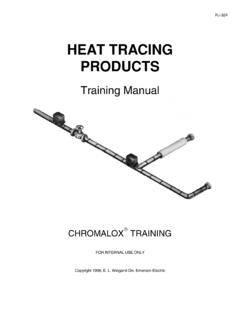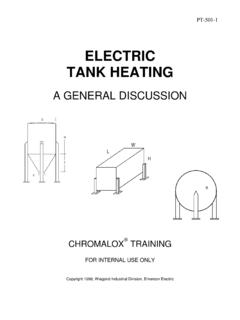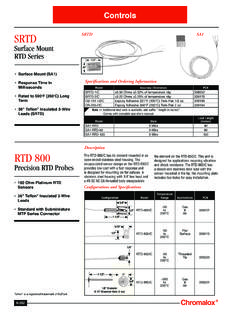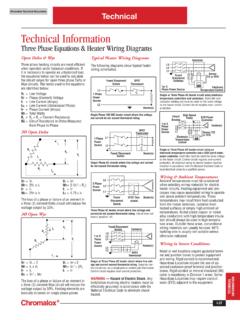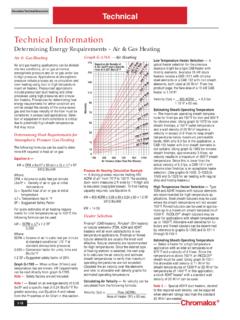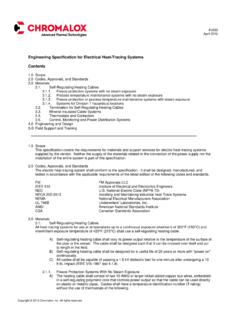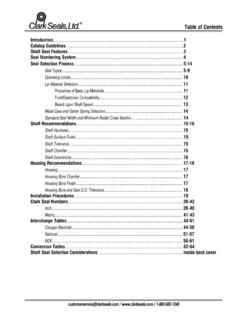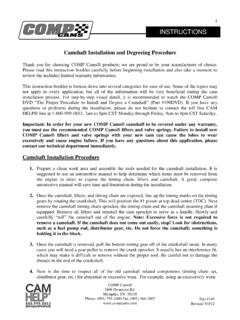Transcription of ELECTRIC TANK HEATING - Chromalox
1 ELECTRICTANK HEATINGA GENERAL DISCUSSIONCHROMALOX TRAININGFOR INTERNAL USE ONLYC opyright 1998, Wiegand Industrial Division, Emerson ElectricPT-501-1 Chromalox TANK HEATING - A General DiscussionTRAININGPage 2 Copyright 1998, Wiegand Industrial Division, Emerson ELECTRIC ByAdam Heiligenstein& Hank NeubertChromalox IndustrialWiegand Industrial ELECTRIC Alpha , PA 15238(412) 967-3800 Revised 3/99 The facts and the recommendations made in thispublication are based on our own research and theresearch of others and are believed to be cannot anticipate all conditions under which thisinformation and our products or the products ofother manufacturers in combination with ourproducts may be used. We accept no responsibilityfor results obtained by the application of thisinformation or the safety and suitability of ourproducts either alone or in combination with otherproducts.
2 Users are advised to make their owntests to determine the safety and suitability of eachsuch product or product combination for their HEATING - A General DiscussionCHROMALOX TRAININGPage 3 Copyright 1998, Wiegand Industrial Division, Emerson ELECTRIC HEATING of tanks is a common industrial practice in many applications. Heatingmay be required to maintain pumping viscosity of heavy oil or resins, to preventcrystalline precipitation (sodium hydroxide), to facilitate production processes, for freezeprotection, and hundreds of other applications. Chromalox offers literally hundreds ofways of HEATING tanks of all sizes. Included in this guide is an overview of the types oftank HEATING approaches. The manual is not meant to be a complete guide to each ofthese HEATING methods, rather an overview of what is available.
3 Once a specificmethod is selected, further investigation should be made into the suitability of theheater for the application. Finally, the manual is a detailed guide on sizing heaters forlarge tanks. This guide includes sizing details that are beyond the scope of the sizingguide presented in the general SIZING INFORMATIONFor any application it is essential that complete data be obtained and understood beforean evaluation and selection of a suitable HEATING system can be made. Specifically youwill need: Specific heat Heated material specific gravity and/or density Temperature rise or temperature to be maintained Heat up or temperature recovery times Process additions to tank Volume Incoming temperature Minimum low ambient temperature exposure Tank size, configuration, material of construction, and detail of nozzles andlegs Insulation Thickness k-factor Hazardous/non-hazardous service area Location - indoor/outdoor Wind conditions - velocity Environmental considerations Code TANK HEATING - A General DiscussionTRAININGPage 4 Copyright 1998, Wiegand Industrial Division.
4 Emerson ELECTRIC MARKETS AND APPLICATIONSN early every major industrial process requires tank HEATING in some form or major industries employing extensive tank facilities are: Refining and petrochemical operations Waste and environmental operations Terminal installations loading/unloading Pulp and paper operations Water storage and fire towers Utilities Mining operations Bulk storage, bins and silos Agriculture plants Food production plants HEATED MATERIALSA list of some materials commonly stored and heated in tanks is listed as follows:A. Liquids and aqueous based solutions: Liquid carbon dioxide Liquid chlorine Aqueous ammonia Water Process De-ionized De-mineralized Potable Waste Fire towers Acids Solvents Resin and resin Food items: Vegetable cooking oils Molasses Syrups Sucrose (liquid sugar) HEATING - A General DiscussionCHROMALOX TRAININGPage 5 Copyright 1998, Wiegand Industrial Division, Emerson ELECTRIC Petroleum products.
5 Benzene Naptha Paraffin Lubricating oils Crank case (SAE 5 to SAE 50) Gear oils ASTM Asphalt compound Emulsions Cut backs Penetration Fuel oils No 1 kerosene No 2 (PS-100) Air craft fuels and domestic oil HEATING No 3 (PS-200) Air craft fuels and domestic oil HEATING No 4 No 5 HEATING oils for factory, commercial & mfg. process HEATING No 6 Bunker C Waste oils Synthetic and heat transfer TANK HEATING - A General DiscussionTRAININGPage 6 Copyright 1998, Wiegand Industrial Division, Emerson ELECTRIC OF STORAGE TANKSS torage tanks encountered vary in size depending upon their application. In general,they can be classified as follows:A. Medium tanks 500 to 1000 gallons B. Large tanks of 1000 to 10 thousand gallonsC.
6 Very large tanks 10 thousand gallons and are many approaches to HEATING tanks of these sizes. The many solutions thatChromalox offers are reviewed in the next addition to storage tanks, many other tanks are employed in manufacturingprocesses, such as:A. Finishing tanksB. Wash and rinse tanksC. Cooking vesselsOpen top tanks used in these applications typically employ over-the-side heatingassemblies as well as screw plug or flanged immersion assemblies. This manual maybe used for sizing small open top tanks. Please note, however, that this manualincludes much more detail than is typically required for sizing small process tanks. It isrecommended that you consult the P120 or the P2000 for some additional , a computer based calculation tool is available that is designed specifically forrectangular open or closed top tanks used in the finishing industry.
7 Contactheadquarters for more HEATING - A General DiscussionCHROMALOX TRAININGPage 7 Copyright 1998, Wiegand Industrial Division, Emerson ELECTRIC INTRODUCTION TO TANK HEATING DESIGNSC hromalox offers the broadest range of tank HEATING solutions in the ELECTRIC heatingindustry. There are two main methods to tank HEATING ; direct and indirect tank HEATING consists of placing the heater in direct contact with the heatedmedium by placing the heater directly in the tank or circulating the fluid directly throughthe tank HEATING uses a heat transfer medium to apply the heat to the methods can vary from external HEATING of the tank using the tank wall as theheating medium to utilizing a heat transfer medium to carry the heat to the heaters or systems can be utilized in direct and indirect methods and appear inboth sections of this TANK HEATINGD irect HEATING places the heater in direct contact with the heated medium.
8 The heatingelement is immersed in the process fluid utilizing various mounting advantage of HEATING directly is that the heaters are nearly 100% efficient with thismethod. This is because all heat that is generated is absorbed directly by the helps to speed heat-up and eliminate thermal lag. There is no intermediate heattransfer medium that could result in heat disadvantages of direct HEATING include the element surface limitation of the heaterto deliver the energy. Large surface areas require more space for the heater. If thetank is small there may not be room for a properly sized heater. Additionally,consideration of the heater material must be made to insure that the element iscompatible and will not degrade due to corrosion or pitting from the process.
9 Becauseof the efficient heat transfer with directly immersed heaters, the relative watt density istypically high in these applications. Therefore, the heater must be designed so that it isnot exposed to air while operating which could lead to heater failure due to highelement temperatures. Finally, the element must be protected from sludge build up inthe tank that could limit the elements ability to transfer the heat. Figure 2 is anexample of immersion heater mounting and demonstrates installation mounting positionabove sludge line and below fluid review of direct HEATING methods with the application pictures are shown throughoutthe next TANK HEATING - A General DiscussionTRAININGPage 8 Copyright 1998, Wiegand Industrial Division, Emerson ELECTRIC HEATING USING SCREW PLUG IMMERSION HEATERSS crew plug immersion heaters are typically applied in small tanks or reservoirs requiringrelatively small amounts of heat.
10 Many of the tanks are open top style and are used inthe finishing industry or industrial process tanks. Many screw plug heaters include abuilt-in mechanical thermostat, which can often control the heater without any additionalequipment. Chromalox , however, typically recommends the use of an over temperaturecut out and/or level 3: Mating a screwplug heater to the tankFigure 1: Typical screw plug immersion heater installationsFigure 2: Mounting a direct HEATING styleimmersion heaterTANK HEATING - A General DiscussionCHROMALOX TRAININGPage 9 Copyright 1998, Wiegand Industrial Division, Emerson ELECTRIC HEATING USING FLANGED IMMERSION HEATERSB ecause screw plugs havelimited element space flangedheaters are used for largerwattage applications.
